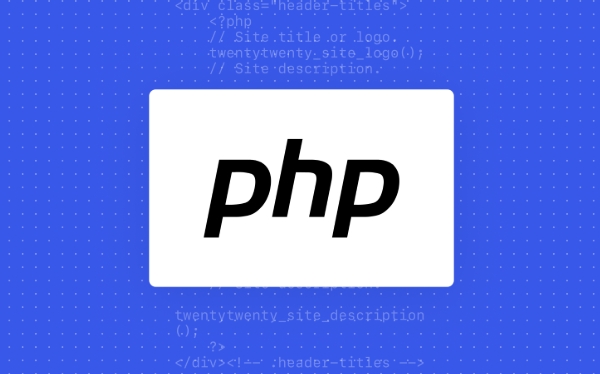 Backend Development
Backend Development
 PHP Tutorial
PHP Tutorial
 Beyond `isset()`: A Deep Dive into Validating and Sanitizing $_POST Arrays
Beyond `isset()`: A Deep Dive into Validating and Sanitizing $_POST Arrays
Beyond `isset()`: A Deep Dive into Validating and Sanitizing $_POST Arrays
Aug 02, 2025 pm 04:36 PMisset() alone is insufficient for secure PHP form handling because it only checks existence, not data type, format, or safety; 2. Always validate input using filter_input() or filter_var() with appropriate filters like FILTER_VALIDATE_EMAIL to ensure correct format; 3. Use empty() to check for required fields, but be cautious with values like "0" that may be valid; 4. Implement manual validation for complex rules such as password strength using strlen() and preg_match(); 5. Sanitize data using htmlspecialchars(), strip_tags(), or up-to-date filter functions to prevent XSS, avoiding deprecated options like FILTER_SANITIZE_STRING; 6. Handle arrays safely by verifying type with is_array() and sanitizing each element, optionally using recursive functions for nested data; 7. Follow security best practices including server-side validation, prepared statements for SQL, output escaping, and CSRF protection; 8. A complete approach combines existence checks, validation, and context-aware sanitization to ensure data integrity and application security, as demonstrated in the example where email, name, and age are properly validated and sanitized before use, resulting in safer, more reliable applications.

When handling form data in PHP, relying solely on isset() to check $_POST variables is a common starting point—but it's often not enough. While isset() tells you whether a variable exists and isn't null, it doesn't confirm data type, format, or safety. To build secure and reliable applications, you need to go beyond simple existence checks and implement proper validation and sanitization of $_POST data.

Let’s explore why isset() falls short and how to properly handle user input.
Why isset() Isn’t Enough
Consider this typical check:

if (isset($_POST['email'])) {
$email = $_POST['email'];
}This only confirms the key exists. But what if:
- The value is an empty string?
- It contains malicious HTML or script tags?
- It’s not a valid email format?
- It’s an array when you expect a string?
isset() returns true in all these cases. That’s why additional steps are essential.

1. Validate: Confirm Data Meets Expected Criteria
Validation ensures data is in the correct format, type, and within acceptable bounds. PHP provides several tools for this.
Use filter_input() and filter_var()
These functions allow you to validate and sanitize using built-in filters.
$email = filter_input(INPUT_POST, 'email', FILTER_VALIDATE_EMAIL);
if (!$email) {
die('Invalid email format.');
}This not only checks existence but also validates the email structure.
Other useful validation filters:
FILTER_VALIDATE_INTFILTER_VALIDATE_URLFILTER_VALIDATE_BOOLEANFILTER_VALIDATE_FLOAT
Validate Required Fields with empty()
Unlike isset(), empty() checks both existence and "truthiness":
if (empty($_POST['username'])) {
die('Username is required.');
}Note: empty() returns true for "", 0, "0", null, false, and []. Be cautious with fields where 0 is valid.
Manual Validation for Complex Rules
For custom logic (e.g., password strength, min/max length):
$password = $_POST['password'] ?? '';
if (strlen($password) < 8) {
die('Password must be at least 8 characters.');
}
if (!preg_match('/[A-Z]/', $password)) {
die('Password must contain an uppercase letter.');
}2. Sanitize: Clean Data Before Use
Sanitization removes or encodes unwanted characters while preserving safe, usable data.
Use filter_input() with Sanitization Filters
$name = filter_input(INPUT_POST, 'name', FILTER_SANITIZE_STRING); // Removes tags and encodes special chars
?? Note:
FILTER_SANITIZE_STRINGis deprecated as of PHP 8.1. Use alternatives likehtmlspecialchars()orstrip_tags()instead.
Manual Sanitization Examples
$name = htmlspecialchars($_POST['name'] ?? '', ENT_QUOTES, 'UTF-8'); $email = filter_var($_POST['email'], FILTER_SANITIZE_EMAIL); $url = filter_var($_POST['url'], FILTER_SANITIZE_URL);
For arrays (e.g., multiple checkboxes), sanitize each item:
$tags = $_POST['tags'] ?? [];
$sanitized_tags = array_map('htmlspecialchars', array_map('trim', $tags));3. Handle Arrays and Nested Data Safely
Forms can submit arrays, and blindly accessing them can lead to errors.
Check Type Before Processing
$colors = $_POST['colors'] ?? null;
if (!is_array($colors)) {
die('Colors must be an array.');
}
$safe_colors = [];
foreach ($colors as $color) {
$clean = filter_var(trim($color), FILTER_SANITIZE_STRING);
if (!empty($clean)) {
$safe_colors[] = $clean;
}
}Use Recursive Sanitization for Nested Structures
function sanitize_array($data) {
$result = [];
foreach ($data as $key => $value) {
$key = filter_var($key, FILTER_SANITIZE_STRING);
if (is_array($value)) {
$result[$key] = sanitize_array($value);
} else {
$result[$key] = filter_var($value, FILTER_SANITIZE_STRING);
}
}
return $result;
}
$clean_post = sanitize_array($_POST);4. Security Best Practices
- Never trust user input. Assume all
$_POSTdata is dangerous until proven otherwise. - Validate on the server. Client-side validation can be bypassed.
- Use prepared statements when inserting data into databases to prevent SQL injection.
- Escape output with
htmlspecialchars()when displaying user data in HTML. - Set appropriate content types and use CSRF tokens for sensitive actions.
Example: Complete Form Handling
$errors = [];
$data = [];
if ($_SERVER['REQUEST_METHOD'] === 'POST') {
// Validate email
$email = filter_input(INPUT_POST, 'email', FILTER_VALIDATE_EMAIL);
if (!$email) {
$errors[] = 'A valid email is required.';
} else {
$data['email'] = $email;
}
// Validate and sanitize name
$name = trim($_POST['name'] ?? '');
if (empty($name)) {
$errors[] = 'Name is required.';
} else {
$data['name'] = htmlspecialchars($name, ENT_QUOTES, 'UTF-8');
}
// Validate age
$age = filter_input(INPUT_POST, 'age', FILTER_VALIDATE_INT, [
'options' => ['min_range' => 1, 'max_range' => 120]
]);
if ($age === false) {
$errors[] = 'Age must be a number between 1 and 120.';
} else {
$data['age'] = $age;
}
if (empty($errors)) {
// Process valid data
echo "Hello, {$data['name']}! You're {$data['age']} years old.";
} else {
foreach ($errors as $error) {
echo "<p style='color:red;'>$error</p>";
}
}
}Going beyond isset() means treating every $_POST value as untrusted. Combine existence checks with type validation, format rules, and sanitization tailored to how the data will be used—whether in HTML, SQL, or external APIs.
The extra effort pays off in fewer bugs, better UX, and stronger security.
Basically, isset() is just the first gate. What happens after matters far more.
The above is the detailed content of Beyond `isset()`: A Deep Dive into Validating and Sanitizing $_POST Arrays. For more information, please follow other related articles on the PHP Chinese website!

Hot AI Tools

Undress AI Tool
Undress images for free

Undresser.AI Undress
AI-powered app for creating realistic nude photos

AI Clothes Remover
Online AI tool for removing clothes from photos.

Clothoff.io
AI clothes remover

Video Face Swap
Swap faces in any video effortlessly with our completely free AI face swap tool!

Hot Article

Hot Tools

Notepad++7.3.1
Easy-to-use and free code editor

SublimeText3 Chinese version
Chinese version, very easy to use

Zend Studio 13.0.1
Powerful PHP integrated development environment

Dreamweaver CS6
Visual web development tools

SublimeText3 Mac version
God-level code editing software (SublimeText3)

Hot Topics
 PHP Variable Scope Explained
Jul 17, 2025 am 04:16 AM
PHP Variable Scope Explained
Jul 17, 2025 am 04:16 AM
Common problems and solutions for PHP variable scope include: 1. The global variable cannot be accessed within the function, and it needs to be passed in using the global keyword or parameter; 2. The static variable is declared with static, and it is only initialized once and the value is maintained between multiple calls; 3. Hyperglobal variables such as $_GET and $_POST can be used directly in any scope, but you need to pay attention to safe filtering; 4. Anonymous functions need to introduce parent scope variables through the use keyword, and when modifying external variables, you need to pass a reference. Mastering these rules can help avoid errors and improve code stability.
 How to handle File Uploads securely in PHP?
Jul 08, 2025 am 02:37 AM
How to handle File Uploads securely in PHP?
Jul 08, 2025 am 02:37 AM
To safely handle PHP file uploads, you need to verify the source and type, control the file name and path, set server restrictions, and process media files twice. 1. Verify the upload source to prevent CSRF through token and detect the real MIME type through finfo_file using whitelist control; 2. Rename the file to a random string and determine the extension to store it in a non-Web directory according to the detection type; 3. PHP configuration limits the upload size and temporary directory Nginx/Apache prohibits access to the upload directory; 4. The GD library resaves the pictures to clear potential malicious data.
 Commenting Out Code in PHP
Jul 18, 2025 am 04:57 AM
Commenting Out Code in PHP
Jul 18, 2025 am 04:57 AM
There are three common methods for PHP comment code: 1. Use // or # to block one line of code, and it is recommended to use //; 2. Use /.../ to wrap code blocks with multiple lines, which cannot be nested but can be crossed; 3. Combination skills comments such as using /if(){}/ to control logic blocks, or to improve efficiency with editor shortcut keys, you should pay attention to closing symbols and avoid nesting when using them.
 How Do Generators Work in PHP?
Jul 11, 2025 am 03:12 AM
How Do Generators Work in PHP?
Jul 11, 2025 am 03:12 AM
AgeneratorinPHPisamemory-efficientwaytoiterateoverlargedatasetsbyyieldingvaluesoneatatimeinsteadofreturningthemallatonce.1.Generatorsusetheyieldkeywordtoproducevaluesondemand,reducingmemoryusage.2.Theyareusefulforhandlingbigloops,readinglargefiles,or
 Tips for Writing PHP Comments
Jul 18, 2025 am 04:51 AM
Tips for Writing PHP Comments
Jul 18, 2025 am 04:51 AM
The key to writing PHP comments is to clarify the purpose and specifications. Comments should explain "why" rather than "what was done", avoiding redundancy or too simplicity. 1. Use a unified format, such as docblock (/*/) for class and method descriptions to improve readability and tool compatibility; 2. Emphasize the reasons behind the logic, such as why JS jumps need to be output manually; 3. Add an overview description before complex code, describe the process in steps, and help understand the overall idea; 4. Use TODO and FIXME rationally to mark to-do items and problems to facilitate subsequent tracking and collaboration. Good annotations can reduce communication costs and improve code maintenance efficiency.
 Quick PHP Installation Tutorial
Jul 18, 2025 am 04:52 AM
Quick PHP Installation Tutorial
Jul 18, 2025 am 04:52 AM
ToinstallPHPquickly,useXAMPPonWindowsorHomebrewonmacOS.1.OnWindows,downloadandinstallXAMPP,selectcomponents,startApache,andplacefilesinhtdocs.2.Alternatively,manuallyinstallPHPfromphp.netandsetupaserverlikeApache.3.OnmacOS,installHomebrew,thenrun'bre
 How to access a character in a string by index in PHP
Jul 12, 2025 am 03:15 AM
How to access a character in a string by index in PHP
Jul 12, 2025 am 03:15 AM
In PHP, you can use square brackets or curly braces to obtain string specific index characters, but square brackets are recommended; the index starts from 0, and the access outside the range returns a null value and cannot be assigned a value; mb_substr is required to handle multi-byte characters. For example: $str="hello";echo$str[0]; output h; and Chinese characters such as mb_substr($str,1,1) need to obtain the correct result; in actual applications, the length of the string should be checked before looping, dynamic strings need to be verified for validity, and multilingual projects recommend using multi-byte security functions uniformly.
 Learning PHP: A Beginner's Guide
Jul 18, 2025 am 04:54 AM
Learning PHP: A Beginner's Guide
Jul 18, 2025 am 04:54 AM
TolearnPHPeffectively,startbysettingupalocalserverenvironmentusingtoolslikeXAMPPandacodeeditorlikeVSCode.1)InstallXAMPPforApache,MySQL,andPHP.2)Useacodeeditorforsyntaxsupport.3)TestyoursetupwithasimplePHPfile.Next,learnPHPbasicsincludingvariables,ech





